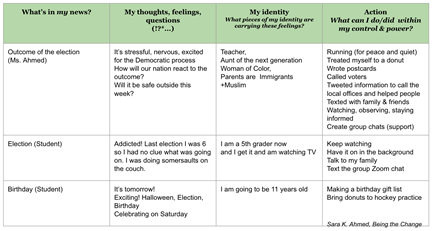After a year of challenge, there is hope on the horizon. The vaccine is reaching communities in need, schools are making plans to reopen in-person learning, and families are finding greater financial stability. On top of that, the days are getting longer and the sun is shining more! It seems there is much to be hopeful for, but as recent reports indicate an increase in anti-Asian hate crimes across the country, we are reminded that there is still important and urgent social justice work to be done.
Anti-racist educator Dena Simmons recently wrote in response to the rise in anti-Asian hate crimes,
“We must remember racial justice and anti-bias work exist beyond a Black and white binary. The Asian, Indigenous, and Latinx communities must be a part of any work labeled ‘diverse,’ ‘culturally responsive,’ and ‘anti-racist.’”
When our students enter our classrooms, they come with bits and pieces of news from home, their social media feeds, and from conversations with friends. This news can create a sense of fear and worry for some, as well as generate lots of unanswered questions. Tackling these tough topics in the classroom can be a challenge, especially for educators who come from different backgrounds than their students. Despite the uncertainty of what to say, it’s imperative that we honor our kids’ news and engage in dialogue that explores their questions. This process will open students up to a range of perspectives and nurture critical thinking skills.
So for those of you committed to anti-bias anti-racist work “beyond the binary,” we’re sharing a great lesson structure that will:
- Move your classroom from student-centered to socially minded,
- Allow kids to initiate the exploration of topics they care about, and
- Facilitate a more informed understanding of current events.
What’s in Our News?
Adapted from Being the Change (@SaraKAhmed)
PURPOSE: The following lesson gives kids the opportunity to express the things that are on their mind and explore questions they have about their news. The lesson structure is perfect for those days when “the world hands you your curriculum” (@katricequitter) or as a regular, daily/weekly SEL check-in. Examining students’ news helps them to process what’s happening in the world around them and to practice important social comprehension skills as they listen and dialogue with others.
PREP: Create a space for students to record their news. They can write in a notebook, on an anchor chart (with or without teacher support), or through a digital platform like Google Slides. Label one side of the page, “What’s in My News?” and the other side, “My Thinking.”
1. MODEL THE PROCESS: Start by saying, “There are lots of things happening in the world right now and there are also things in ‘my news’ that are on my mind.” Then model your thinking as you write down a few items that are in “your news.” These might be as big as current events and news headlines, or as personal as a family birthday coming up or a trip to the vet with your pet. Now, share your thinking in the next column, including any personal thoughts, questions, ideas, and/or worries.
 Link to blank Google Slides template and example
Link to blank Google Slides template and example
2. STUDENTS WRITE: Now give students an opportunity to write down what’s on their mind by asking, “What’s in your news?” This can be done individually, as students record on their own papers or as a group, calling on a few students to share aloud.
3. SHARE YOUR NEWS: Whether the routine is done individually or as a group, be sure to hold space for students to share their news, a connection to the news of others, feelings, wonderings, questions, etc. This can be done using a Turn and Talk structure and/or whole group discussion. Remember, you don’t have to have answers to students’ questions or find solutions to their challenges. The lesson is really about checking in with kids and honoring what they observe, hear,see, and feel. It helps everyone see the unique lived experiences of others and helps to facilitate understanding across differences.
EXTENDING THE LESSON:
- Keep the newsfeed lesson alive by revisiting it weekly or on occasion.
- Connect student news to their personal identity (gender identity, race, ethnicity, culture, religion, sexual identity/orientation, language, interests, personality, etc). This helps kids see how their understanding of the world can grow and change as they view it from different perspectives.
- Extend the chart to include a column titled, “My Ideas for Action.” Here students can channel their emotions and develop an action plan to become more informed on the topic, for example by finding out more information, talking to others, writing about it, etc.
Looking for help to continue anti-bias anti-racist work in your classroom? Not sure how to tackle tough topics such as race, gender, politics, religion and sexuality in a developmentally appropriate way? We’ve got 2 great courses that provide the information, resources, and applicable strategies you need to make change in your classroom and school community.
5107: Empathy and Social Comprehension for a Compassionate Classroom
Based on the text, Being the Change, by Sara K. Ahmed, the course will give you and your students the confidence, skills, and tools to explore tough questions and facilitate dialogue courageously in your learning environment. Covering topics like identity, bias, perspective-taking, and intent vs. impact, you will come away with specific lessons and strategies to help you nurture your students’ comprehension of social issues.
5128: Creating an Anti-Racist Classroom
Talking about race, though challenging, is necessary, no matter your race, background, or comfort level. In this powerful course, you will examine your own racial socialization and learn about the complex history of race in America. Once you’ve made these critical connections between past and present, you will explore ways to facilitate productive dialogue around race and identity, and learn anti-biased/anti-racist approaches to classroom instruction.


